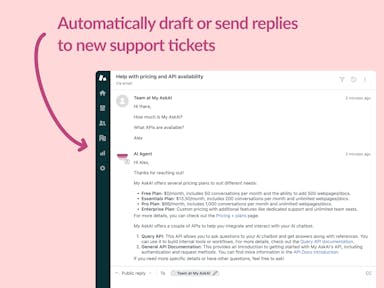Understanding OAuth Scope Parameter in Zendesk
What is the purpose of the 'scope' parameter in OAuth requests?
The 'scope' parameter in OAuth requests defines the level of access your application has to Zendesk resources. It is crucial for controlling permissions.
You can specify scopes like 'read', 'write', or 'impersonate' to determine what actions your app can perform. For instance, 'read' allows access to GET endpoints, while 'write' permits creating, updating, and deleting resources. You can also fine-tune access to specific resources like tickets or users. For more details on setting scopes, see theoriginal documentation.
More related questions
How do I register my application with Zendesk for OAuth authentication?
To use OAuth authentication with Zendesk, you need to register your application to generate OAuth credentials. This process involves creating an OAuth client in the Zendesk Admin Center. To register your application, navigate to Admin Center, click…
What are the different types of OAuth clients in Zendesk?
Zendesk supports two types of OAuth clients: Public and Confidential. These types determine how securely your application's credentials can be stored. Public OAuth clients are used in environments where credentials cannot be securely stored, such…
How can I implement an OAuth authorization flow in my application?
Implementing an OAuth authorization flow in your application involves several steps to securely obtain access tokens from Zendesk. The process starts by sending the user to the Zendesk authorization page, where they can grant your application…
How do I handle the user's authorization decision in my application?
Handling the user's authorization decision is a key step in the OAuth flow, where your application processes the user's choice to grant or deny access. After the user makes a decision on the Zendesk authorization page, the response is sent to your…
How can I use an access token in Zendesk API calls?
Once you have an access token, you can use it to authenticate API calls to Zendesk, allowing your application to access data securely. Include the access token in the HTTP Authorization header of your API requests. For example, use 'Authorization:…
Interested indeflectingover 70% of your Zendesk support tickets?

Zendesk Support Tickets


Zendesk Messaging (live chat)

Join1,000+ companies reducing their support costs and freeing up support agents for more important work
“We needed an AI agent integrated within our current tools. My AskAI was the only solution that wasn't going to disrupt our operations.”
Zeffy
“At the end of last year I was given the challenge - how can we provide the same or better service, without hiring anyone?”
Zinc
“My AskAI blew everybody else out of the water. It made the selection process very easy for us.”
Customer.io($50M+ ARR)

“It now resolves 71% of queries (over 35,000 every month), meaning more time solving complex issues and improving UX.”
Freecash

“We needed an AI agent integrated within our current tools. My AskAI was the only solution that wasn't going to disrupt our operations.”
Zeffy

“At the end of last year I was given the challenge - how can we provide the same or better service, without hiring anyone?”
Zinc

“My AskAI blew everybody else out of the water. It made the selection process very easy for us.”
Customer.io($50M+ ARR)
“It now resolves 71% of queries (over 35,000 every month), meaning more time solving complex issues and improving UX.”
Freecash







Reduce support costs.Spend more time on customer success.

